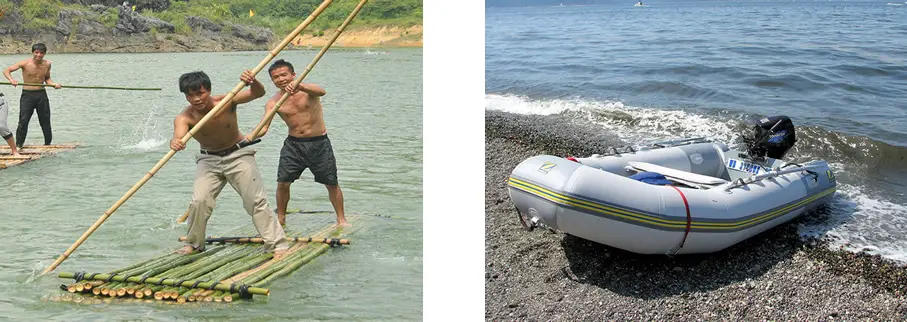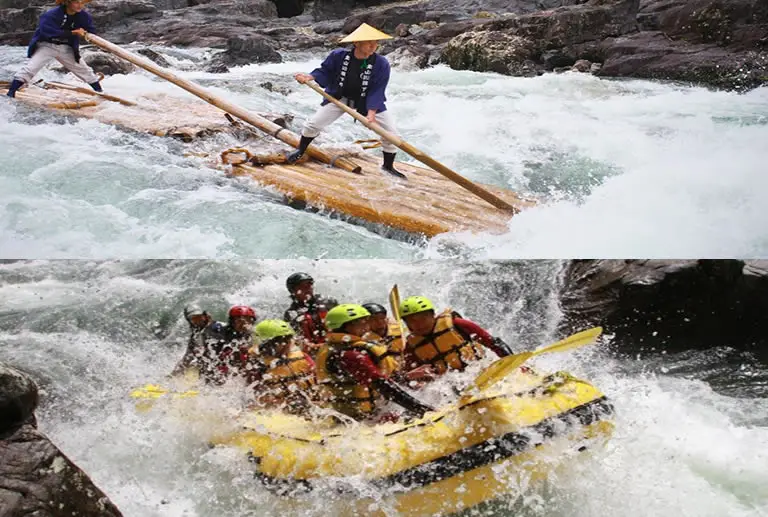Contents
What Is A Raft & How Is It Used?
Before we explore both the traditional raft and the modern raft and their uses, let’s examine what a raft is.
A raft is the very simplest type of watercraft. A traditional raft is a flat platform that is made from timber logs that have been fastened together with braided fibers or rope. Historically a raft was used to transport people and goods along rivers and other water bodies.
Most modern rafts are inflatables used for river and whitewater recreational pursuits or for fishing.
As a boat, the raft lacks any type of engineering or clever design.
The traditional raft is the most basic type of boat you can get. Modern rafts are only marginally more engineered as they stick to the same basic design.
A traditional raft is a large float without the functions for steering other than a pole for punting. Modern rafts can be propelled the same way but can also be fitted with oars and can even be motorized.
A Short History Of Rafts
Rafts were originally a means of transporting timber logs downstream. The feller would gather the logs together and tie them up as a float or raft, whilst pulling them down the river on a leash.
Once this design became popular fishing also became an activity performed on a river raft.
In modern times, the recreational sport of rafting, and modern rafting tours, have taken the fore when it comes to using rafts – with inflatables being the mode of choice for descending down white water rapids.
Rafts are likely to have been among the first design of boats used by mankind. Along with canoes, wooden rafts are the kind of marine vessel that was used by our ancestors to experiment in navigating oceans, seas, rivers and lakes.
There is a natural buoyancy advantage with traditional rafts, which are typically made with wooden logs or reeds, tightly tied together, that you don’t get with most other boats.
By design, rafts don’t displace water in the same fashion that a boat with a deep v-hull does, and instead interact with the water surface in the same way as other flat-bottomed boats.
Rafts tend to “sit on” the water rather in it.
The main purpose of traditional rafts historically
There are two well-recognized purposes generally associated with the historic use of rafts. They are:
- Transportation.
- Fishing.
The raft was instrumental in helping primitive cultures to fulfill the two necessities of communities the world over. These are:
- The ease of movement of goods and supplies from one location to another.
- A method for attaining a fresh food supply.
Traditional raft design & construction
Historical rafts were made from any buoyant material found in the natural world, such as logs or bamboo sticks, which were fastened together with braided fibers taken from plants such as vines.
Later, in the pioneer times for example, when rope became available, this was used to lash the logs together.
There are still modern bamboo rafts in use today for a variety of tasks from fishing and transportation to tourism.
How wooden rafts were constructed by lumberjacks
A peculiar practice known as “timber rafting” has been adopted by logger men throughout the ages and across the world as a means of quick transportation on rivers.
Timber rafting is a resourceful way of using felled trees.
The process involves lumberjacks gathering together, at times hundreds, of logs after felling them and lining them up on the water. In this way they are able to make massive makeshift rafts.
These mega-rafts are so effective that making and using them is a customary mode of transport for timber enterprises worldwide.
Aboard such innovative feats of engineering, sometimes hundreds of lumberjacks at a time can be found under shelters where they can bake in makeshift ovens and even care for livestock in temporary stables – all onboard the makeshift mega raft construction.
In such cases, oars are used for steering and not for propulsion. The natural current is used to move the raft.
There are drawbacks to the traditional raft design
Although the basic design of a raft makes it easy to construct it does come with some challenges.
Maneuverability is a critical flaw with raft boats. Without a keel for the aid of direction or a sail for propulsion, there is total dependence on rowers or punters to guide the watercraft.
On the sea, rafts offer no protection against the waves, and can be swamped easily and quickly.
Being without sides of any kind, should rough waters arise, the passengers and cargo of a raft will get drenched by the water and likely washed overboard.
Modern raft design & construction – The 4 Types Of Modern Raft
Modern rafts have a slightly different design that their traditional cousins. They have “sides” and can be rigid boats or inflatable.
Modern rafts are usually made from one of the following four materials:
- Rubber – material used for inflatable rafts.
- Urethane – lightweight and puncture resistant but expensive.
- Hypalon – Cheaper and usually glued together so not as resistant.
- PVC – Cheap plastic that is lightweight.
These materials have there own strengths and weaknesses.
Modern rafts are designed to address the flaws of the traditional raft
Modern rafting, that is closer to home, is less linked to commercial fishing, transportation or utility work and more twinned with recreational pursuits.
Modern rafting in America and most of the world usually comes in 2 types:
- Rafting tours.
- Whitewater rafting.
Although you may occasionally see someone fishing from a raft this is a much less common sight in the western world than it was in pioneer times.
3 Uses Of The Modern Raft
Modern rafts are usually used for one or more of the following three reasons.
Whitewater rafting
When it comes to rafting most people will think of whitewater rafting and for good reason.
Whitewater rafting is a hugely popular outdoor recreational pursuit for soloists and teams alike. During this activity, rafters use an inflatable raft like one of these to race down rushing rapids with only the aid of a paddle or oar for control.
This activity has attracted the term whitewater rafting because it accurately describes the appearance of the fast rapid water as it foams and froths along its course.
Whitewater rapids are also a popular spot for kayaks – though a specially designed whitewater kayak is required to ride rapids as it is very dangerous.
Extreme, natural ecological gradients like mountains, valleys and canyons provide the steepness needed for the water to build up speed.
Boulders in the river that act as obstacles to the speeding water, or drops in elevation of the river bottom which cause turbulence to the rushing wasters, turn those areas of the river into high-velocity watercourses, known as rapids.
From the earliest journaled account of whitewater rafting, written by Lieutenant John Fremont (of the US Army) in 1842 – whitewater rafting has barely changed at all. Back then, Fremont’s raft was constructed from 4-rubber cloth tubes crudely tied together, covered with a wrap-around material floor.
Today, the commercially manufactured rafts are no more further advanced in design – but more nuanced in assembly and better engineered in material complexity i.e. they are tougher but have the same basic deign.
It was in the 1960’s that whitewater rafting took on its highly popularized modern form. Iconic routes like the Grand Canyon were adopted by specialist tour companies which soon grew in popularity as they delivered the type of white-knuckled experience that thrill-seekers still enjoy today.
Whitewater rafting, also known as whitewater canoeing (even though a raft is used), was first showcased as an Olympic sport in the 1972 Munich Games. The competition was hosted on the world’s first artificial whitewater concrete channel, the Eiskanal in Augsburg, Germany.
Another notable artificial white watercourse is the 2012 Olympic whitewater rafting venue, Lea Valley in Hertfordshire, costing some £31 million ($38.6 million) to develop.
Modern raft fishing
Although fishing on a raft is a matter of tradition for many around the world it is a waning tradition, especially in America, where there are so many excellent alternatives.
However, there is at least one country close-by that still enjoys raft fishing and has a large number of raft fishermen – Brazil.
A wooden raft known as Jangada (which can be a traditional Brazilian fishing boat as well as a raft) is used to indulge in the art of traditional fishing and is quite a fruitful commercial enterprise for many Brazilians. The expert fishermen using such structures are called Jangadeiros.
Made entirely out of wood, without any metal fixtures or fittings, the seafaring jangada is usually constructed from 6 lightweight Balsa logs all strapped together. It has a mast in the middle of the raft for harnessing the thrust of the wind.
A seat is propped against the sail and is occupied by the pilot of the raft. This is called the “master’s seat”.
The passengers of the Jangada are usually 3 – 5 in total.
On a typical voyage, the boat could take a 3 -5 day round-trip on the sea with the raft offering no real protection for the fishermen against the water, wind and rain.
Rafting tours
Rafting, in the correct conditions and appropriate waters, can be a really fun activity.
Rafting tours, like those in Sweden and other Nordic countries, are poplar and exciting ways to navigate very calms waterways with amazing scenery while there is also the option to ride rapids in fjords.
Of course there are rafting tours much closer to home with some of the most popular trips taking place in Yellowstone, The Grand Canyon and Idaho among many other places. A simple Google search will help you find rafting activities and tours close to you.
Raft Propulsion Methods
Raft builds and designs are quite broad, but all are extensions on the traditional theme of a buoyant platform with or without a sail, and steered by oar or pushed by pole.
Interestingly enough, traditional wooden rafts are still favored by many around the world for fishing and for minor transport runs between locales.
Modern rubber rafts have sides as well as a front and a back, unlike traditional wooden rafts that are just flat platforms. This may be one reason the Olympics refer to their whitewater rafting competition as white water canoeing (as mentioned above).

Powering a raft: motorized vs paddle vs pole
A modern raft can be motorized or manually propelled by oars or pole or paddle. Traditional rafts are almost always punted by a pole.
The benefit of motorized rafts is the speed at which they are able to traverse the course. It is common place to see a motorized raft move at twice the pace of the flow of the river.
Conclusion: What Is A Raft & How Is It Used
A raft is a multi-purpose boat with a very basic design that is used for travelling atop seas, rivers, lakes and other waterways.
In times past, rafts were made from wooden logs that were tied together to form a single flat platform and were purposed for practical uses to courier people and supplies from one place to another, or as vessels for fishing.
Modern rafts are usually inflatable crafts that are mostly used for whitewater rapid rides and tours but can also be used for fishing.

